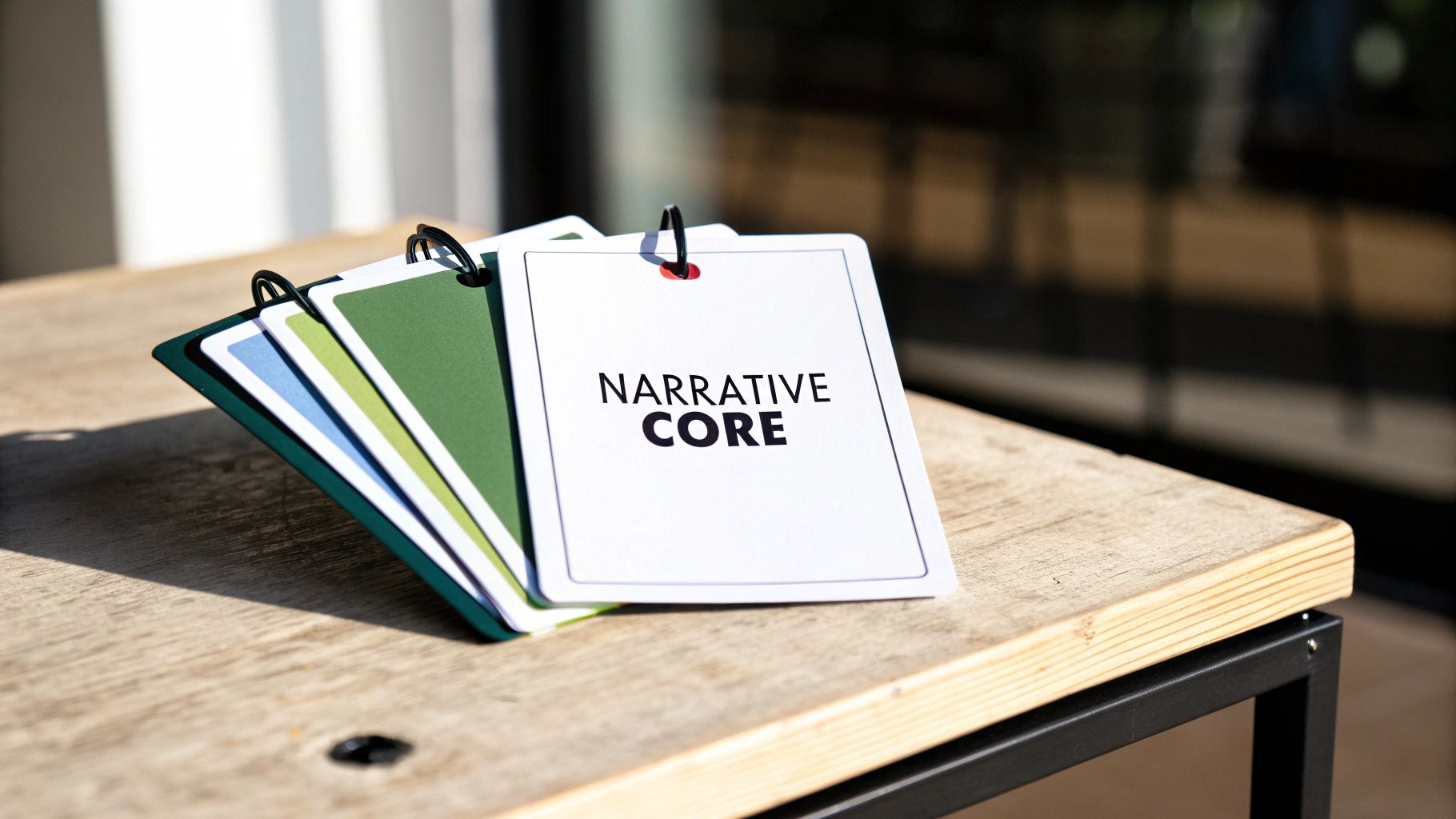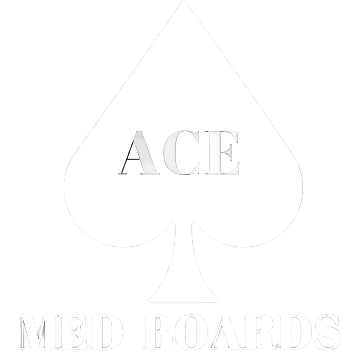Think of your personal statement outline as the architectural blueprint for your story. It's what turns a random collection of experiences into a powerful, cohesive narrative that guides the admissions committee right where you want them to go. Without it, you risk rambling. With it, every single paragraph has a purpose.
Why a Strong Outline Is Your Secret Weapon
Let me be blunt: jumping straight into writing your personal statement without an outline is one of the biggest mistakes you can make. It's a critical first step.
Admissions officers are wading through hundreds, sometimes thousands, of these essays. A clear, logical structure is what makes your story stick in their mind instead of getting lost in the shuffle. Even the most incredible experiences will fall flat if they feel disconnected or poorly paced. An outline prevents that.

From Checklist to Compelling Story
Your personal statement isn't just a long-form CV. It's a story that needs to reveal your character, your resilience, and what truly drives you. An outline is the tool that helps you weave your accomplishments into that story, rather than just listing them.
Think of it this way: the process is similar to creating an autobiography outline. It forces you to pinpoint a central theme—the "why" behind your entire application—and then cherry-pick only the most impactful anecdotes that support it.
This planning phase is non-negotiable because you have a shockingly short window to make an impression. A 2023 survey found that 40% of graduate admissions officers spend five minutes or less on a personal statement. Very few will give it more than 15 minutes. This is precisely why your essay needs to be tight, well-structured, and captivating from the very first sentence.
Before we dive into the specifics, let's look at the basic structure your outline will create. Each part has a distinct job to do.
The Four Pillars of an Effective Outline
| Section | Objective |
|---|---|
| The Hook (Introduction) | Grab the reader's attention immediately with a compelling anecdote or image. |
| The "Why Medicine" Core | Connect your personal story to your motivation for pursuing medicine. |
| The Experience Deep Dive | Showcase key experiences (clinical, research, etc.) and what you learned. |
| The "Why This Program" & Conclusion | Articulate your future goals and explain why this specific program is the right fit. |
This framework isn't just about organizing paragraphs; it's about building a persuasive argument for your candidacy, piece by piece.
Key Takeaway: An outline forces you to be intentional. It ensures your intro hooks them, your body paragraphs build a logical case, and your conclusion leaves a powerful, lasting impression. It’s the difference between a forgettable essay and an unforgettable one.
Crafting an Unforgettable Introduction
Your opening paragraph is your one shot to make a lasting first impression. Admissions committees read thousands of essays, so you have to grab their attention from the very first sentence.
Forget the generic openers like, “I have always wanted to be a doctor.” Your real goal is to drop the reader right into a pivotal moment that defines your journey to medicine. This is a classic storytelling technique called starting in media res—in the middle of the action.

This means you plunge your reader directly into a powerful patient interaction, a complex lab experiment that went sideways, or a personal challenge that solidified your commitment. By starting with a vivid, specific scene, you create instant intrigue and set the stage for the rest of your essay. If you want to get into the weeds of it, it’s all about the psychology of first impressions.
From Vague to Vivid
Let’s look at two different hooks to see why this works so well.
A weak, forgettable hook might say something like, "Volunteering at the clinic taught me the importance of empathy." This is telling, not showing. It states a conclusion without inviting the reader into the experience.
Now, compare that to a strong hook: "The sterile scent of antiseptic couldn't mask the fear in Mrs. Gable’s eyes as I fumbled with the blood pressure cuff for the third time." See the difference? This example is powerful because it shows a moment in time. It’s loaded with sensory details and emotional stakes that make the reader want to know what happens next.
Key Takeaway: Your introduction shouldn't be a summary of your entire journey. It needs to be a single, compelling snapshot—a doorway that invites the reader into the larger story of who you are.
This narrative hook is probably the most important part of your personal statement outline. It’s the anchor for your entire story. Other powerful ways to start include:
- Posing a thought-provoking question: Frame a question that came out of a specific experience, one that your essay will eventually answer.
- Sharing a surprising realization: Describe a specific moment when your entire perspective on medicine or patient care shifted.
All of these approaches are designed to forge a personal connection and introduce the core motivation you’ll explore throughout your statement. For a deeper dive into organizing your whole essay, check out our complete guide on how to write a personal statement.
Your introduction is the promise of a great story. Make it count.
Building Your Narrative Core
You've hooked them with a great intro. Now what? The body of your personal statement is where you make good on that initial promise. This section is the real heart of your story—it's where you finally connect the dots between your past experiences and your future in medicine.
When you're outlining your statement, this is where you should spend most of your energy.
The goal here isn't to just rattle off every single achievement from your CV. Instead, you need to be selective. Pick just two or three pivotal experiences that genuinely shaped who you are. Think about the moments that really tested your resilience, sparked your curiosity, or solidified your empathy. These are the building blocks of your entire argument.

Structuring Each Mini-Narrative
For each experience you choose, think of it as its own mini-story with a beginning, middle, and end. This "show, don't tell" approach is way more powerful than just flat-out stating what you learned.
For each story, try to follow this simple structure:
- The Scene: Briefly set the stage. Where were you? What was going on? Paint a quick mental picture for the reader so they feel like they're right there with you.
- Your Action: Get specific about what you did. This is all about your role and the choices you made, not just what was happening around you.
- The Reflection: This is, without a doubt, the most important part. What did you learn about yourself, about patient care, or about the field of medicine? How did this experience change you and lock in your decision to become a doctor?
That reflective piece is what separates a mature, self-aware applicant from one who is just listing activities. It elevates your essay from a simple report to a thoughtful analysis of your journey. To see this in action, checking out a sample medical school personal statement can give you a much clearer idea of how to blend these elements together effectively.
Weaving a Cohesive Story
Your chosen experiences shouldn't feel like they came out of left field. They absolutely have to tie back to the central theme you kicked things off with in your hook.
For instance, if your introduction was about a communication barrier with a non-English-speaking patient, your body paragraphs could then explore other experiences that highlight your dedication to cultural competency and compassionate communication. It all has to connect.
Pro Tip: Think thematically, not chronologically. Does one experience showcase your problem-solving chops in a research lab, while another demonstrates your empathy during a clinical rotation? Grouping your stories by the qualities they reveal creates a much stronger and more memorable narrative than just listing things as they happened. This is how you make sure your narrative core is both compelling and cohesive.
Connecting Your Story to Their Program
This is where everything comes together. You've spent most of your personal statement building a compelling narrative about your journey and what drives you. Now, in your final body paragraph, it's time to pivot from the past to the future and answer the single most important question for the admissions committee: "Why us?"
This is your chance to show you’ve done your homework. Generic compliments about a school's "excellent reputation" or "diverse patient population" fall completely flat. Adcoms can spot them a mile away, and they show zero genuine interest.
Making It Personal
Admissions committees aren't just looking for good grades and clinical hours; they want to see how you think. They’re looking for applicants who have thoughtfully considered how they’ll fit into the incoming class and contribute to the program's unique community. For more tips on showcasing these qualities, you can find some great insights on upgrad.com.
To make this connection feel real and not just tacked on, you have to get specific. Pinpoint concrete features of their program that genuinely excite you and align with your story.
- A Specific Research Lab: Instead of saying you're interested in research, mention a professor by name. You could say, "Dr. Chen's work in neurodegenerative diseases directly builds on my undergraduate research into protein folding, and I'm excited by the possibility of contributing to her lab."
- A Unique Clinical Rotation: Don't just mention "global health opportunities." Talk about their specific global health track in rural Peru and connect it to your long-term goal of working with underserved communities abroad.
- A Distinctive Curriculum: Highlight their problem-based learning (PBL) model. Explain how it perfectly suits your hands-on learning style, which you already proved you have through your experiences as an EMT.
This level of detail does more than just flatter the program. It proves you're not just carpet-bombing applications. You're making a clear, evidence-based argument for why you belong at their institution, and nowhere else.
The Bottom Line: Ditch the vague praise. Your goal is to find 1-2 truly unique aspects of the program—a specific professor, a clinic, a curriculum track—and draw a direct line from them back to your own experiences and future ambitions. This is what turns a good story into a targeted, unforgettable application.
Crafting a Conclusion That Sticks
This is it—your final chance to leave a lasting impression. You've brought the admissions committee this far, and a weak ending can unfortunately undercut an otherwise fantastic essay. Your goal here is to be memorable, confident, and leave them with a clear sense of your purpose.
Think of the conclusion less as a summary and more as a synthesis. You're not just repeating what you've already said; you're weaving your core message together into one final, powerful statement that reinforces your central theme.

Unifying Your Narrative
One of the most powerful ways to end your statement is to bring your story full circle. Remember that compelling hook you started with? Circle back to it.
If you began with an anecdote about a particular patient, you could briefly touch on that moment again. But this time, frame it with the new perspective you've gained throughout all the experiences you've just described. This technique provides a deeply satisfying sense of closure for the reader, making your entire narrative feel intentional and complete.
Your conclusion should also be forward-looking. Briefly articulate the kind of physician you want to be, making sure to connect that vision back to the skills and values you’ve already demonstrated. This doesn't just show them who you are now; it paints a clear picture of the person you're striving to become.
Final Polish Tip: Read your very last sentence out loud. Does it land with confidence? Does it sound definitive and hopeful? The final words of your essay should echo in the reader’s mind long after they’ve put it down.
As you polish your ending, make sure you're avoiding a few common pitfalls that can weaken your impact.
- Don't suddenly introduce a brand-new story or experience. The time for new evidence is over.
- Don't rely on clichés like "In conclusion…" or the generic "I am passionate about helping people." Show it, don't just say it.
- Don't hedge your commitment. Avoid timid phrases like "I think I would be a good doctor."
Instead, aim to finish with a concise, powerful statement that cements your unwavering commitment and genuine excitement for the next chapter of your medical journey.
Answering Your Personal Statement Outline Questions
Building a personal statement outline can bring up a lot of questions. It's totally normal to feel a bit lost in the details, but getting a few key things straight from the start can make the whole process feel much more manageable. Let's walk through some of the most common questions I hear from applicants.
How Long Should It Be?
This is usually the first question on everyone's mind. While it varies a bit by application service, the gold standard is a powerful, single-page document. For an ERAS personal statement, that typically means landing somewhere in the 750-850 word range.
Your outline should map this out: a compelling intro, about 3-4 solid body paragraphs, and a concise conclusion. Planning for this structure helps you stay within the limit without feeling rushed. For a more granular look at character counts and strategy, check out our in-depth guide to ERAS personal statement length.
Should My Outline Follow a Timeline?
Absolutely not. In fact, you should actively avoid a chronological structure. Just walking an admissions committee through your CV is a huge missed opportunity. A thematic outline is far more sophisticated and effective.
Instead of a play-by-play of your activities since you started undergrad, group your experiences around core themes. You might have one paragraph that showcases your leadership skills and another that highlights moments of profound empathy. This approach builds a cohesive argument about who you are as a person, not just a list of things you've checked off.
A thematic outline proves you can connect disparate experiences to a central mission—a skill highly valued in medicine. It shows deep reflection and an ability to synthesize information, not just recount it.
How Many Experiences Should I Include?
Here's a simple rule: quality over quantity. Your outline should revolve around two or three truly significant moments that define your journey to medicine.
Trying to cram everything in will make your statement feel shallow and hurried. Pick the stories that best support your core message and give yourself enough room to unpack them with meaningful reflection. Show them how you grew, what you learned, and why it matters. That’s what they really want to see.
Crafting a standout personal statement is a crucial step in your medical journey. At Ace Med Boards, we specialize in helping you translate your unique experiences into a powerful narrative that gets you noticed. Schedule a free consultation to learn how our admissions experts can guide you.
